The Functioning of The Differential Items on The Physics Learning Result Test Device at MAN Tegal City
Main Article Content
Abstract
This study aims to (1) analyze the characteristics of the physics questions tested at MAN Tegal City, (2) find out which questions were detected with DIF (3) analyze the confidence plot on the test items for the end of the 2020/2021 school year assessment test. at MAN Tegal City. The population in this study were all students of MAN Tegal City. As for the sample, all the answer sheets of students who took the final assessment test for the 2020/2021 school year on physics subjects consisting of 337 answer sheets. Data collection is by using the documentation method. The analysis technique uses Rasch modeling with Wald test. From the results of this study, it was concluded that (1) there were characteristics in the form of differences in the level of difficulty of the final assessment items for the 2020/2021 school year in physics subjects tested on class XI students at MAN Tegal City, (2) the results of the DIF detection analysis using the Wald test. shows empirical facts that in the final assessment test kit for the 2020/2021 school year physics class XI at MAN Tegal City there are no questions containing DIF, (3) the confidence plot can be used properly on the test kit.
Article Details
With the receipt of the article by the Editorial Board of the Cakrawala: Jurnal Ilmu Pendidikan and it was decided to be published, then the copyright regarding the article will be diverted to Cakrawala: Jurnal Ilmu Pendidikan.
Cakrawala: Jurnal Ilmu Pendidikan hold the copyright regarding all the published articles and has the right to multiply and distribute the article under Creative Commons Attribution-NonCommercial 4.0 International License.
A copyright transfer from the author to the journal is done by filling out the copyright transfer form by the author.
Copyright Transfer Letter: Download
Creative Commons Attribution-NonCommercial 4.0 International License
References
Andayani, A., Purwanto, & Ramalis, T. R. (2019). Kajian implementasi teori respon butir dalam menganalisis instrumen tes materi fisika. Prosiding Seminar Nasional Fisika 5.0, 1(1), 37–42.
Bond, T. G., Yan, Z., & Heene, M. (2020). Applying the rasch model: Fundamental measurement in the human sciences. In Applying the Rasch Model: Fundamental Measurement in the Human Sciences. https://doi.org/10.4324/9780429030499
Engelhard Jr., G., & Wind, S. (2017). Invariant measurement with raters and rating scales: Rasch models for rater-mediated assessments. In Invariant Measurement with Raters and Rating Scales: Rasch Models for Rater-Mediated Assessments. https://doi.org/10.4324/9781315766829
Fernanda, J. W., & Hidayah, N. (2020). Analisis Kualitas Soal Ujian Statistika Menggunakan Classical Test Theory dan Rasch Model. Square : Journal of Mathematics and Mathematics Education, 2(1), 49. https://doi.org/10.21580/square.2020.2.1.5363
Green, K. E., & Frantom, C. G. (2002). Survey Development and Validation With the Rasch Model. International Conference on Questionnaire Development, Evaluation, and Testing, January 2002, 42.
Hadi, S., Basukiyatno, B., & Susongko, P. (2021). Differential Item Functioning National Examination on Device Test Mathematics High School in Central Java. https://doi.org/10.4108/eai.30-11-2020.2303726
Hartono, W., Hadi, S., Rosnawati, R., & Retnawati, H. (2022). Uji Kecocokan Model Parameter Logistik Soal Diagnosa Kemampuan Matematika Dasar. JNPM (Jurnal Nasional Pendidikan Matematika), 6(1), 125–144.
Hutabarat, I. M. (2009). Analisis Butir Soal dengan Teori Tes KLasik (Classical Test Theory) dan Teori Respons Butir (Item Response Theory). PYTHAGORAS: Jurnal Pendidikan Matematika, 5(2).
Lamprianou, I. (2019). Applying the Rasch Model in Social Sciences Using R. In Applying the Rasch Model in Social Sciences Using R. https://doi.org/10.4324/9781315146850
Lendert, R. M., Aulele, S. N., & Lesnussa, Y. A. (2019). Analisis Pengaruh Daerah Asal Sma Terhadap Nilai Ujian Mahasiswa Dengan Menggunakan Uji Wald-Wolfowitz. VARIANCE : Journal of Statistics and Its Applications, 1(1), 11–15. https://doi.org/10.30598/variancevol1iss1page11-15
Liu, X., & Jane Rogers, H. (2022). Treatments of Differential Item Functioning: A Comparison of Four Methods. Educational and Psychological Measurement, 82(2). https://doi.org/10.1177/00131644211012050
Mulyani, S., Efendi, R., & Ramalis, T. R. (2021). Karakterisasi Tes Keterampilan Pemecahan Masalah Fisika Berdasarkan Teori Respon Butir. JURNAL Pendidikan Dan Ilmu Fisika, 1(1), 1. https://doi.org/10.52434/jpif.v1i1.1006
Nafiati, D. A., Sukirno, S., & Mulyani, E. (2022). Entrepreneurial Attitudes and Interpersonal Communication in Teaching Students. Cakrawala: Jurnal Pendidikan, 16(2), 77–87. https://doi.org/10.24905/CAKRAWALA.V16I2.338
Retnawati, H. (2013). Pendeteksian Keberfungsian Butir Pembeda Dengan Indeks Volume Sederhana Berdasarkan Teori Respons Butir Multidimensi. Jurnal Penelitian Dan Evaluasi Pendidikan, 17(2), 275–286. https://doi.org/10.21831/pep.v17i2.1700
Retnawati, H. (2015). Karakteristik Butir Tes dan Analisisnya. Uny, 53(5), 1–116.
Rosidah, N. A., Ramalis, T. R., & Suyana, I. (2018). Karakteristik Tes Keterampilan Berpikir Kritis ( Kbk ). Jurnal Inovasi Dan Pembelajaran Fisika, March, 54–63.
Safihin, M. (2019). Pengembangan Tes Menggunakan Model Rasch Materi Gaya Untuk SMA. Jurnal Pendidikan Dan Pembelajaran, 8(6), 1–11.
Santosa, A. D., Sartika, S. H., Surgawati, I., & Doi, : (2022). Increasing Student’s Learning Motivation and Learning Outcomes through the Application of Participant Centered Learning (PCL) Cards. Cakrawala: Jurnal Pendidikan, 16(2), 88–98. https://doi.org/10.24905/CAKRAWALA.V16I2.340
Science, P., & Journal, E. (2020). Pancasakti Science Education Journal. Pancasakti Science Education Journal, 5, 4–11. https://doi.org/10.24905/psej.v6i2.127
Setiawan, A. (2020). KEBERFUNGSIAN BUTIR DIFERENSIAL MENGGUNAKAN PERMODELAN RASCH PADA PENILAIAN AKHIR SEMESTER IPA DI SMP NEGERI KABUPATEN.
Susongko, P., Arfiani, Y., & Kusuma, M. (2021). Determination of gender differential item functioning in tegal-students’ scientific literacy skills with integrated science (Slisis) test using rasch model. Jurnal Pendidikan IPA Indonesia, 10(2). https://doi.org/10.15294/jpii.v10i2.26775
Susongko, P. (2016). VALIDATION OF SCIENCE ACHIEVEMENT TEST WITH THE RASCH MODEL. JPII, 5(2), 268–277. https://doi.org/10.15294/jpii.v5i2.7690
Susongko, Purwo. (2019). Aplikasi Model Rasch Dalam Pengukuran Pendidikan Berbasis Program R. Badan Penerbitan Universitas Pancasakti Tegal.
Triyatno, N., & Ngazizah, N. (2014). Bias Gender Ujian Akhir Semester Genap Fisika Kelas X SMA Negeri Kabupaten Purworejo Tahun Pelajaran 2012/2013. Nur Triyatno, 4(1), 34–37.

